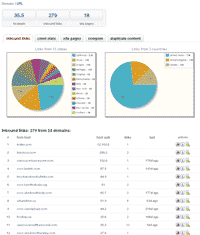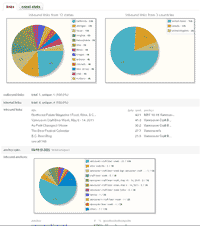It seems like every year a new “Google killer” comes around, and each time they fail to even make a dent in the three (now two, sadly) search giants market control. This time it’s the poorly named Blekko (bringing to mind either a character out of Nancy or a cat coughing up a hairball), whose selling point is a combination of social sharing features, a “slash tag” method of narrowing search results, and a full suite of SEO tools.
For the most part none of these are particularly appealing. The social sharing looks like it was pulled from any one of a million blogs, the slash tags just a slightly souped up version of functions already available in most search engines, and the SEO tools… well, who cares enough about Blekko to care about SEO for it, yeah?
But on second glance, these SEO tools aren’t all that bad. They aren’t a gift from God or anything, but they can give you some good competitive information for trying to match up with other sites.
In this post I’m going to take a brief look at some of the functionality that Blekko provides, and how it might be useful to the modern SEO.
Links

I know this is the first thing you all clicked when you started using Blekko. The prospect of a search engine that tells you what links are pointing at a page (any page) is incredibly tempting. However, much like the Google link: modifier, things are not as they seem.
Blekko displays a selection of links – not all links. I don’t know if this is because they just don’t spider all of the links to a page, or because they don’t want to give everything away. I’m going to guess the latter since when you click over to the “SEO” tab the number of inbound links changes (much higher in my experience). I’m guessing they’re playing the same game that Google used to play with the links: tag, displaying “important” links. Of course, if this is the case then they suck at displaying important links, given how many are multiples from the same domain, or links from social media such as twitter.
What *is* cool is that you can sort links by date, seeing when they were indexed, and in turn letting you get an inkling of a site’s link growth. That said, if it’s only showing you a selection of links then this might not be as useful as it seems.
Either way, though, this is a decent, free, way to find out what links a competitors site has that you are missing.
SEO
Domain stats

The SEO page is much more interesting than the links page. For one you can get a breakdown of linking domains. Again, none of these numbers add up. If you take the number of links from each of the listed domains you don’t get the total inbound links. I really don’t get why Blekko is doing this, since it it’s just going to make people trust them less.
Crawlstats is a little cooler. It gives you a sites IP address and other sites hosted on the same server, as well as number of pages seen. Why would you want this info? Well, for the most part its pretty useless, but some times you can use it to track down multiple sites by the same people, and find all sorts of other Internet dectectivy things.
Site pages seems cool, giving you the pages it recognizes and it’s ranking. Sadly, its hard to give their ranking any meaning since we don’t know if Google/Bing are using a methodology with any similarity.
Compare seemed neat at first, comparing stats between multiple domains. However, after a few minutes I remembered the chaos surrounding link numbers and realized that this data is likely specific to Blekko, not real useful outside of that.
Duplicate content might be useful, but it seems to show a lot of false positives, so I’m not going to go very deep into it. It doesn’t tell you a lot (I couldn’t find WHAT content was duplicated) and so I’m not sure if its really serving the purpose it wants. It has a lot of promise though, and maybe after they’ve been at it for a while it will become a very useful feature of the site.
URL stats

But wait, there’s more! If you click the “url” link next to “domain” near the top of the page, suddenly the stats switch to be URL specific, which opens up a lot of options. Why did they hide all this behind such a small word? Who knows.
This gives us all sorts of new info, including inbound link anchor text, outbound links, by URL duplicate content (which, this time, tells you what content is duplicated) and… actually not a whole lot more. Most of the info here is pretty specific to Blekko.
Conclusions
Blekko isn’t as bad as the name makes it sound. However, the name makes it sound like vomit so… The information here actually holds a lot of promise, and if they can get over a few of the difficulties with the data reliability, it could become a very useful tool for SEOs.
The question is: do they want to? Blekko as a tool to improve your ranking in Google seems to defeat Blekko’s goal, and as such I would not be surprised if they decided not to provide too much information that might be useful to people using their competitors.
Anyway, it’ll be interesting to watch for the next few weeks and see if it turns into an SEO tool, or goes the way of search engines like Cuil.
















